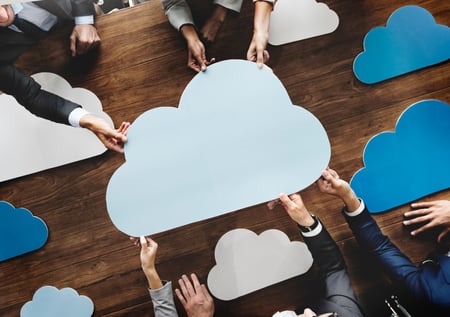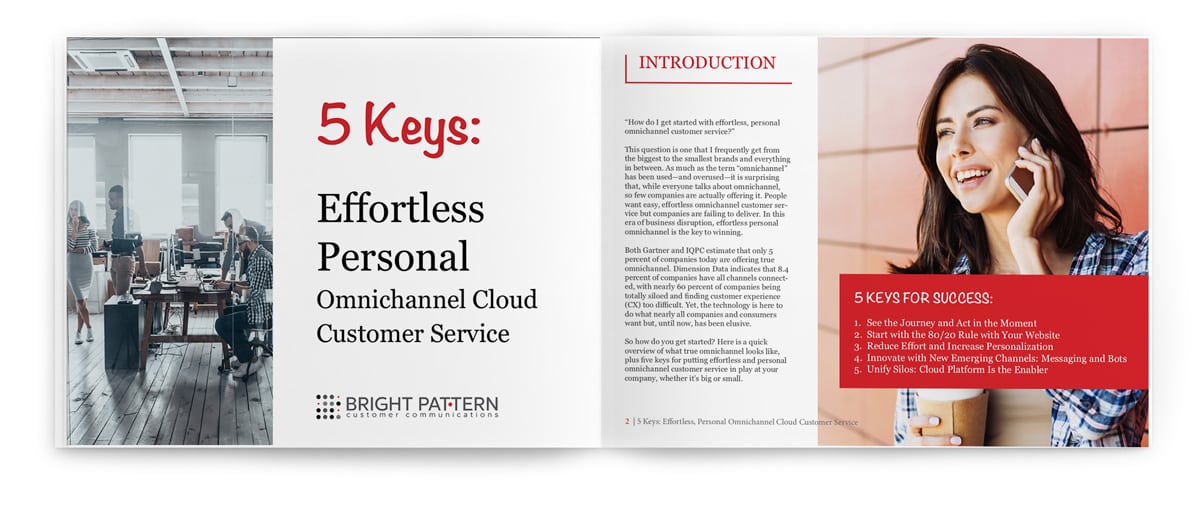
Last week we launched Part one of our Effortless, Personal Omnichannel Customer Service blog series and gave you our top two tips! You learned in Part one what makes a true omnichannel contact center and why omnichannel is the key to survival (be the disruptor, not the disrupted!). In Part two we will leave you with three more keys to making omnichannel customer service effortless and personal.
KEY #3: REDUCE EFFORT & INCREASE PERSONALIZATION
First, why is it important to reduce effort? I think for each of us, as consumers, the answer is obvious. From an ROI perspective, there’s a lot to consider when approaching effortless CX. There are some great stats in one of my favorite customer service books: The Effortless Experience: Conquering the New Battleground for Customer Loyalty, by Matthew Dixon, Nick Toman, and Rick DeLisi of the Corporate Executive Board (CEB), a subsidiary of Gartner.
In The Effortless Experience, the authors note that with low effort, 94 percent of customers will repurchase from your business, but if your business is high effort, then only 4 percent will. Similarly, with low effort, 88 percent of customers will purchase more from your business, but with high effort, only 4 percent will. Finally, if your effort is low, then only 1 percent of customers will spread bad “word of mouth” reviews, versus 81 percent if effort is high. In today’s social media-driven world, word-of-mouth feedback that can be spread virally to tens of thousands of people is especially critical.
What Goes into Personal Service?
Effortless service clearly pays off, but what about personalized service?
In this age of digital disruption, people talk about how business is getting less personal and higher effort. The truth is that business can actually be easier and more personal with new digital approaches. The future effortless personal journey actually might look familiar. Look to the past to create the future effortless personal journey. It’s like the old hardware store of my grandparents or the diner in the ‘50s, where you would walk in and they knew what you wanted, where you could say, “Please make it the usual, Betty.”
These same personal customer experiences of yesteryear can be created with today’s digital omnichannel customer experiences.
Adding the Personal Touch to CX
There are many ways to create personalized experiences. Here are some tips:
- Ensure that agents have real-time visibility for each customer’s complete journey and interactions across all channels. (How to do this is discussed in Key #5.)
- Use skills-based routing to connect customers from any channel with a preferred agent (e.g., their travel concierge, nurse, personal shopping assistant, financial advice team, etc.).
- Use journey orchestration coupled with your preferred business rules for customers, and treat them according to your business strategy.
As illustrated by these tips, it’s not just about blindly getting two channels working as one with technology—that lowers effort and friction but it doesn’t make it more personal. It’s also about designing and creating effortless, personal journeys that invoke your business rules, routing strategy, and channel choices.
More specifically, consider designing journeys from the “outside in” rather than the “inside out.” Just because you have always had an IVR doesn’t mean you need to offer that to every customer and treat everyone the same with that high-effort IVR—that’s an inside-out approach based on how a company has always operated.
Instead, start with the customers and how they would want to be treated, for the true outside-in approach. For instance, when a gold customer calls in, let them bypass the dreaded IVR and route them to their personal agent or concierge. Or if that same customer hits your website, offer them a personalized proactive chat, and don’t offer that chat option to lower-value customers.
Start with your customer and what they want using an outside-in approach to create great customer journeys, and then implement that in your business rules. Doing so will give you omnichannel that’s as seamless and effortless as it is personal and natural for customers.
By coupling omnichannel technology with your customer-oriented business and customer service goals, service will become more personal, faster, efficient, and even predictive, with lower effort. What’s more, you will beat your competitors.
 KEY #4: INNOVATE WITH NEW EMERGING CHANNELS: MESSAGING & BOTS
KEY #4: INNOVATE WITH NEW EMERGING CHANNELS: MESSAGING & BOTS
You may wonder why we would mention new channels when most companies can’t even get their current channels working as one conversation. As you’ll see in Key #5, there is a solution.
Over three-quarters of larger companies now have web chat (even if it is not omnichannel and integrated with other channels). There is a new emerging channel, however, that industry analysts predict will quickly surpass web chat and will eventually become the biggest, most effortless channel: asynchronous messaging. Though its name is daunting, asynchronous messaging is basically the communication that happens via messaging apps or text messages, the kind of communication that’s on the customer’s schedule and occurs sequentially.
For instance, you may get a text or message back after scheduling a hotel stay via a call or web chat. The message might thank you and ask if you need help with a restaurant recommendation or reservation. You respond when you have time and then the response you get back is instantaneous and according to your schedule. The conversation is persistent, you don’t have to wait on hold, and you can do it when you have time to respond. Messaging is much easier in today’s world of nonstop interruptions.
If you haven’t (yet) heard of asynchronous messaging, one channel you have surely heard of is bot-enabled messaging. Bot adoption has quadrupled in the last year with over half of all companies implementing or considering implementing a bot. People want smarter, brighter bots that provide differentiated help, not dumb bots that don’t carry context when you next contact the company. Bots and humans can work together within a single conversation, providing AI with a human touch.
Ten years ago, when Gartner predicted the “rise of the robots” as a technology trend, I thought, “Here is one they got wrong.” Then last year at a Garter event, I gave a talk, ironically enough, on bots and humans. Gartner was clearly right (as always). And now that robots (like Microsoft’s Cortana and Amazon’s Alexa) are here, we have robots of another sort—chatbots. Although some have positioned this emerging technology as a threat, as in “bots versus humans,” chatbots and humans can actually work together as one in an effortless, omnichannel manner.
Consider these examples:
- A hospitality customer schedules a hotel reservation via a website bot and then asks the bot for a recommendation for a great Italian restaurant for that evening after check-in. The bot should seamlessly escalate to a human with the right skill set—in this case, the concierge, not the hotel front desk. Having the bot seamlessly connected to humans with skills-based routing provides an omnichannel conversation with both bots and humans. How to achieve this is discussed in Key #5.
- A telco customer is frustrated chatting with a bot and this frustration can be seen in words (e.g., “cancel service”) or via sentiment. In this case, the sentiment or words are detected via AI and the customer is then routed to the person who can best prevent the customer from churning—in this case, a customer retention specialist.
- Bots are often positioned as threatening to agents but by having bots handle boring and routine use cases, agents are free to handle more interesting customer service inquiries. Gartner also has predicted that many agents will be training bots in the next few years.
As you look to the future and people’s desire to engage digitally on the channel of their choice, when they decide, these new messaging and bot-enabled channels are key for your company being a digital business that’s a disruptor rather than the disrupted.
What’s important, however, is to make sure these new faster, frictionless messaging channels don’t become new silos that frustrate your customers. Make sure they are seamlessly integrated with other channels as one single continuous conversation. How to do that is discussed in Key #5, but for now, once you have got your top two channels working as one, it is a good idea to consider adding or exploring these new channels. They can give you an edge over the competition and make it much easier for your customers to do business with you.
The fifth and final key is the one that brings all the previous keys to fruition. Think of this as your master key to unlock all the others and make truly effortless, personal omnichannel possible.
If you want to unify and break down silos in your channels to create effortless, personal, omnichannel customer experience, you either need to build or buy an omnichannel orchestration platform. Most companies have tried to build it or bolt it on to existing systems. Large enterprises have spent billions and years and still have not succeeded, which is why just 5 percent of enterprises have adopted omnichannel, and high effort and impersonal customer service remains the norm. Other companies have failed because they have looked to legacy vendors that designed their hardware or on-premise-based software 20+ years ago.
These legacy systems literally took years to implement and were exorbitantly expensive, only available to the largest multi-billion-dollar enterprises, and were very expensive to change with professional services. They leave customers in silos with traditional channels, unprepared to deal with new emerging channels like bots.
 KEY #5: UNIFY THOSE SILOS: THE CLOUD PLATFORM IS A KEY ENABLER
KEY #5: UNIFY THOSE SILOS: THE CLOUD PLATFORM IS A KEY ENABLER
The fifth and final key is the one that brings all the previous keys to fruition. Think of this as your master key to unlock all the others and make truly effortless, personal omnichannel possible. If you want to unify and break down silos in your channels to create effortless, personal, omnichannel customer experiences, you either need to build or buy an omnichannel orchestration platform. Most companies have tried to build it or bolt it on to existing systems. Large enterprises have spent billions and years and still have not succeeded, which is why just 5 percent of enterprises have adopted omnichannel, and high effort and impersonal customer service remains the norm. Other companies have failed because they have looked to legacy vendors that designed their hardware or on-premises-based software 20+ years ago.
These legacy systems literally took years to implement and were exorbitantly expensive, only available to the largest multi-billion-dollar enterprises, and were very expensive to change with professional services. They leave customers in silos with traditional channels, unprepared to deal with new emerging channels like bots.
Companies of Any Size Can Now Turn on Omnichannel
With new cloud microservices, it is now possible to turn on true omnichannel for companies of any size, in a matter of just weeks or months. Bright Pattern is the first built-for-cloud contact center solution offering all channels—from traditional inbound/outbound/blended voice to newer channels like bot- and video/VoIP-enriched live chats and social messengers— natively and seamlessly connected.
The Bright Pattern platform identifies your customers, intelligently routes them based on your business rules, captures con- text over any channel during the customer’s journey, and maintains the customer conversation history, so that the next time the customer reaches out, you can serve them easily and personally.
Achieve Business Agility Without Costly Professional Services
You will want to look to a platform that lets business users make changes quickly and without expensive resources. Bright Pattern allows even business users to self-provision—independently set and configure business rules and routing in the system to be nimble, all without having to bring in IT or professional services teams to implement.
Cloud-First Microservices Architecture for Now and the Future
Old technology is a key reason customer service remains poor and siloed. Customer service is typically siloed because the systems have been siloed systems. Because the Bright Pattern solution was built to be cloud first, not ported from a software solution from 20 years ago, our solution allows you to offer brighter, faster customer service that is effortless, personal, and ominchannel.
Bright Pattern Contact Center provides the flexibility to start with your top two channels if that’s best for you, as well as add your other channels later. What’s more, it future-proofs your customer service offerings so that new emerging channels that incorporate AI and bots or messaging apps don’t become new silos. We work with these digital disruptions, building in capabilities for these channels natively and in the cloud. Bright Pattern provides outstanding service with 99.999 percent uptime, plus on-the-fly upgrades with no loss of service for 10,000+ users in a single instance. And it works with any cloud infrastructure, public or private.
Effortless and Personal Starts with Empowered Agents
Not only does the cloud simplify operations for your business, it also enables your agents to work better and more efficiently. At the heart of the Bright Pattern platform is a unified omnichannel Agent Desktop that lets agents see each channel in a given customer’s conversation and be able to respond on any channel. Today, nearly 70 percent of agents are multiskilled across contact centers, so giving agents a superhero view of all interactions lets them best serve customers, effortlessly and personally across all channels.
Ready for your digital transformation? Download our Full E-Book HERE



